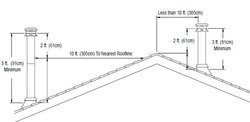- Feb 13, 2013
- 8
Hello all, first post here. I've burned wood before, but always with a masonry chimney in a big old house where you could crank it 24/7 and just monitor the stove pipe temperature and be happy.
Now I've got a much different situation. I want to put a small woodstove in my well-insulated ~700 square foot 2nd story over unheated garage (insulated floor, walls, ceiling in 2nd story). I've got an asphalt shingle roof (7 / 12 slope) and two possible locations for a small stove.
Kitchen location would be near wall and in that case I'm inclined to NOT put a hole in my roof, but to go through the wall and up ten feet or so. My preferred location is living room, chimney going straight up through the attic just to one side of the roof ridge vent (modern, ten year old building here, currently heated with Toyo Laser 73).
I'm a safety first kind of guy, so how 'bout it? Which is safer?
Thanks, and it looks like an excellent forum.
Safe-Burner to be.
Now I've got a much different situation. I want to put a small woodstove in my well-insulated ~700 square foot 2nd story over unheated garage (insulated floor, walls, ceiling in 2nd story). I've got an asphalt shingle roof (7 / 12 slope) and two possible locations for a small stove.
Kitchen location would be near wall and in that case I'm inclined to NOT put a hole in my roof, but to go through the wall and up ten feet or so. My preferred location is living room, chimney going straight up through the attic just to one side of the roof ridge vent (modern, ten year old building here, currently heated with Toyo Laser 73).
I'm a safety first kind of guy, so how 'bout it? Which is safer?
Thanks, and it looks like an excellent forum.
Safe-Burner to be.



